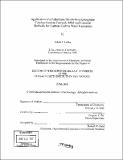| dc.contributor.advisor | Gregory C. Fu. | en_US |
| dc.contributor.author | Littke, Adam F. (Adam Francis), 1974- | en_US |
| dc.contributor.other | Massachusetts Institute of Technology. Dept. of Chemistry. | en_US |
| dc.date.accessioned | 2005-08-24T19:56:03Z | |
| dc.date.available | 2005-08-24T19:56:03Z | |
| dc.date.copyright | 2002 | en_US |
| dc.date.issued | 2002 | en_US |
| dc.identifier.uri | http://hdl.handle.net/1721.1/8049 | |
| dc.description | Thesis (Ph. D.)--Massachusetts Institute of Technology, Dept. of Chemistry, 2002. | en_US |
| dc.description | Vita. | en_US |
| dc.description | Includes bibliographical references. | en_US |
| dc.description.abstract | Our research over the last four years has been focused on the development of mild and general methods for conducting palladium-catalyzed carbon-carbon bond forming reactions utilizing the bulky and electron-rich trialkylphosphine, tri-tert-butylphosphine (P(t-Bu)3). We have concentrated on the utilization of aryl chlorides as substrates due to their lower cost and greater availability compared to traditionally employed aryl bromides, iodides, and triflates. The Suzuki reaction was the first reaction that we investigated, and we were able to develop a first-generation protocol for coupling aryl chlorides with aryl-boronic acids utilizing Pd2(dba)3/P(t-Bu)3 as catalyst and Cs2CO3 as base. A second-generation protocol utilizing KF as base offered significant improvements and provided an opportunity to expand the scope of the reaction. Electron-deficient aryl chlorides underwent Suzuki reaction at room temperature. Hindered substrates and unactivated vinyl chlorides could be coupled efficiently, and turnover numbers as high as 9,700 could be achieved. In addition, we discovered a highly unusual selective coupling of an aryl chloride in preference to an aryl triflate. The next reaction that we examined was the Heck reaction, and we were able to develop a method for coupling aryl chlorides with olefins using Pd/P(t-Bu)3 as catalyst and Cs2CO3 as base. A significant improvement in terms of scope and mildness of conditions was realized with the replacement of Cs2CO3 with Cy2NMe, which allowed for the coupling of sterically and electronically diverse aryl bromides at room temperature, as well as the first room-temperature Heck couplings of aryl chlorides. | en_US |
| dc.description.abstract | (cont.) A wide variety of olefins could be employed in these couplings, including disubstituted olefins. In addition, these Heck reactions could be performed on multigram scale with minimal purification of starting materials, emphasizing the practicality and robustness of this method. Prior to 1999 there were no reports of palladium-catalyzed Stille couplings of unactivated aryl chlorides; utilizing Pd/P(t-Bu)3 in tandem with a fluoride activation strategy, we were able to develop the first general method for Stille couplings of aryl chlorides. More recently, we have considerably increased the scope of this reaction, including the synthesis of tetra-ortho-substituted biaryls, selective couplings of chlorides over triflates, and couplings of some aryl chlorides at room temperature. We have also undertaken mechanistic, kinetic, and reactivity studies using 1H NMR, P NMR, and GC. As a result of these studies, we believe that a monophosphine palladium species is the active catalyst in many of these couplings. The bisphosphine palladium complex Pd(P(t-Bu)3)2 is the resting state; yet by itself it is an ineffective catalyst for room-temperature couplings of aryl chlorides. The addition of phosphine-free Pd2(dba)3 to Pd(P(t-Bu)3)2 generates an efficient catalyst for room-temperature couplings and inspired us to try to utilize crystalline and now commercially available Pd(P(t-Bu)3)2 as a catalyst to eliminate the need to handle air-sensitive P(t-Bu)3. For the most part we have been quite successful in this regard; mixtures of Pd(P(t-Bu)3)2 and Pd2(dba)3 are efficient catalysts for many room-temperature couplings of aryl chlorides. ... | en_US |
| dc.description.statementofresponsibility | by Adam F. Littke. | en_US |
| dc.format.extent | 160 p. | en_US |
| dc.format.extent | 11734732 bytes | |
| dc.format.extent | 11734490 bytes | |
| dc.format.mimetype | application/pdf | |
| dc.format.mimetype | application/pdf | |
| dc.language.iso | eng | en_US |
| dc.publisher | Massachusetts Institute of Technology | en_US |
| dc.rights | M.I.T. theses are protected by copyright. They may be viewed from this source for any purpose, but reproduction or distribution in any format is prohibited without written permission. See provided URL for inquiries about permission. | en_US |
| dc.rights.uri | http://dspace.mit.edu/handle/1721.1/7582 | |
| dc.subject | Chemistry. | en_US |
| dc.title | Application of a palladium/tri-tert-butylphosphine catalyst system towards mild and general methods for carbon-carbon bond formation | en_US |
| dc.type | Thesis | en_US |
| dc.description.degree | Ph.D. | en_US |
| dc.contributor.department | Massachusetts Institute of Technology. Department of Chemistry | |
| dc.identifier.oclc | 51012197 | en_US |
